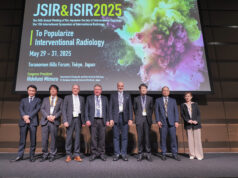
The newly established International Accreditation System for Interventional Oncology Services (IASIOS) gives medical facilities the opportunity to receive credentials for their interventional oncology (IO) service line. Developed by the Cardiovascular and Interventional Radiological Society of Europe (CIRSE), IASIOS focuses on the entire patient pathway, and as such has been heralded as a way of recognising that interventional oncologists are “clinicians, not just technicians”. Andreas ‘Andy’ Adam (Guy’s and St Thomas’ NHS Foundation Trust, London, UK) tells Interventional News that the project “will help establish IO as a mainstream clinical discipline, so is very important to IO as a whole”.
IASIOS is built on the standards outlined in the Standards of quality assurance in interventional oncology document, published in 2018 by CIRSE’s oncology alliance subcommittee, which is chaired by Adam. The idea of a global quality assurance scheme for IO goes back even further, to 2012, when radiation oncologist Lizbeth ‘Liz’ Kenny (Royal Brisbane and Women’s Hospital, Brisbane, Australia) delivered a talk at CIRSE’s annual congress on the interventional oncologist’s place in a multidisciplinary cancer care team.
Kenny emphasised the importance of recognising interventional oncologists as “clinicians, not just technicians”. She recalls: “I thought I was being very provocative, but CIRSE was very supportive. Since then [2012], I have been involved with the oncology alliance subcommittee, and have pushed the importance of standards of practice. In the world of radiation oncology, the stakes are very high, so quality assurance is built into every single step of all we do. I could see that with IO, we either needed to bring it into the mainstream, or it would disappear. IASIOS brings IO into the mainstream—by having a really serious quality assurance and standards programme underpinning the discipline, IO is in a great place to offer high benefit care to patients, and to fully integrate interventional oncologists into the multidisciplinary cancer care team.”
Establishing quality assurance standards in interventional oncology
In 2015, the CIRSE oncology alliance subcommittee—Adam, Kenny, Afshin Gangi (University Hospital Strasbourg, Strasbourg, France), Thierry de Baère (Institut Gustave Roussy, Villejuif, France), José Ignacio Bilbao (Clinica Universidad de Navarra, Pamplona, Spain), Thomas Helmberger (Klinikum Bogenhausen, Munich, Germany), Riccardo Lencioni (Pisa University School of Medicine, Pisa, Italy), and Philippe Pereira (Minimally Invasive Therapies and Nuclear Medicine Heilbronn, Heilbronn, Germany)—worked with interventional oncologist Shahzad Ilyas and former chief medical physicist Keith Ison (both Guy’s and St Thomas’ Hospital, London, UK) to adapt the Standards for Radiation Oncology developed and published by the Royal Australian and New Zealand College of Radiologists (RANZCR), the Australian Institute of Radiography, and the Australasian College of Physicists, Scientists and Engineers in Medicine. The group had to make these standards fit for purpose in the IO environment.
“This was a monumental effort,” Kenny describes. The standards went through 30 iterations over three years prior to publication. “The real complexity was to make the standards simple, understandable, and truly relevant to patients and care providers. This is not a tick box exercise. The standards describe what great care looks like, which then facilitates discussion between interventional oncologists and hospital management over necessary infrastructure, equipment, and patient pathways.”
Following the structure of the Australian and New Zealand Standards for Radiation Oncology, CIRSE’s Standards of Quality Assurance in Interventional Oncology document is split into three sections. These are: staff and facilities, treatment planning and delivery, and safety and quality. The IASIOS accreditation system is based on these standards. Between the three sections, there is a total of 52 criteria, 27 of which are “core”. After paying the enrolment fee, an institution can achieve accreditation if it meets all 27 core criteria. The IASIOS process is interactive: once an IO facility has applied for accreditation, a dialogue begins between it and the IASIOS team in the CIRSE office, which offers advice and guidance on how to improve the service, and is independent from the oncology alliance subcommittee. This conversation continues until accreditation is achieved. In exceptional cases, an institution may be awarded a “centre of excellence” accreditation if it fulfils the remaining 25 criteria.
Guy’s and St Thomas’ NHS Foundation Trust, London, UK, is the first in the world to be accredited through IASIOS. The centre gained accredited status in September 2019.
IASIOS is currently in a pilot phase, with eight centres across Europe, Asia, and Australasia enrolled in the programme to date. Two US centres are poised for potential future participation. CIRSE is working in collaboration with the Society of Interventional Oncology (SIO) to create a version of the IO standards appropriate to the pattern of practice in the USA.
While in this pilot phase of the programme, the IASIOS committee at CIRSE, chaired by Jean Palussière (l’Institut de cancérologie Bergonié, Bordeaux, France), is listening to feedback on the scheme from the enrolled institutions, and making any necessary modifications. Maria Weren, head of the department for certification and accreditation at CIRSE, expands: “I do not expect there to be too many changes at this stage. What I do foresee is some fine-tuning of our assessment process, and possibly to our application forms—so largely modifications to technical details. Any obstacles centres are repeatedly running into our expert group will of course also review.” The official, global launch of IASIOS is planned for early 2021.
Building a global IO network
Kenny is enthusiastic about the potential of the IASIOS scheme to build an international network of interventional oncologists. She tells this newspaper: “In due course, we anticipate building a network of centres that have achieved accreditation. I see this as ultimately an interconnected system of institutions offering support, encouragement, and advice for the betterment of all. IASIOS will uplift the whole of IO.”
There is no precedent for this type of international interconnectivity, Kenny explains: “There is no other movement that does what IASIOS does. The standards define the infrastructure, staffing, and safety requirements to bring IO into mainstream cancer care. If IO is to survive and flourish, it cannot just be a technical specialty under the direction of surgeons or medical and radiation oncologists. Interventional oncologists need to be considered a genuine partner in cancer care, and that is what IASIOS does.”
In Weren’s eyes, too, the IASIOS programme will bring increased recognition to the discipline, through giving interventional oncologists greater control of the entire patient pathway and a louder voice at interdisciplinary meetings. “IASIOS benefits not just patients, but also interventional oncologists,” she opines.
“It is an initiative by interventional oncologists, for interventional oncologists, because the standards look at the whole patient pathway. The standards will introduce systemic preprocedural assessment and patient follow-up by interventional oncologists, which I anticipate will provide greater visibility to IO. Interventional oncologists are ready to assume the role and responsibilities of a specialty, but they need to have a voice and they need to have a fixed place in the multidisciplinary cancer care team. This will enrich the discussion and widen the perspective for the patient.”










